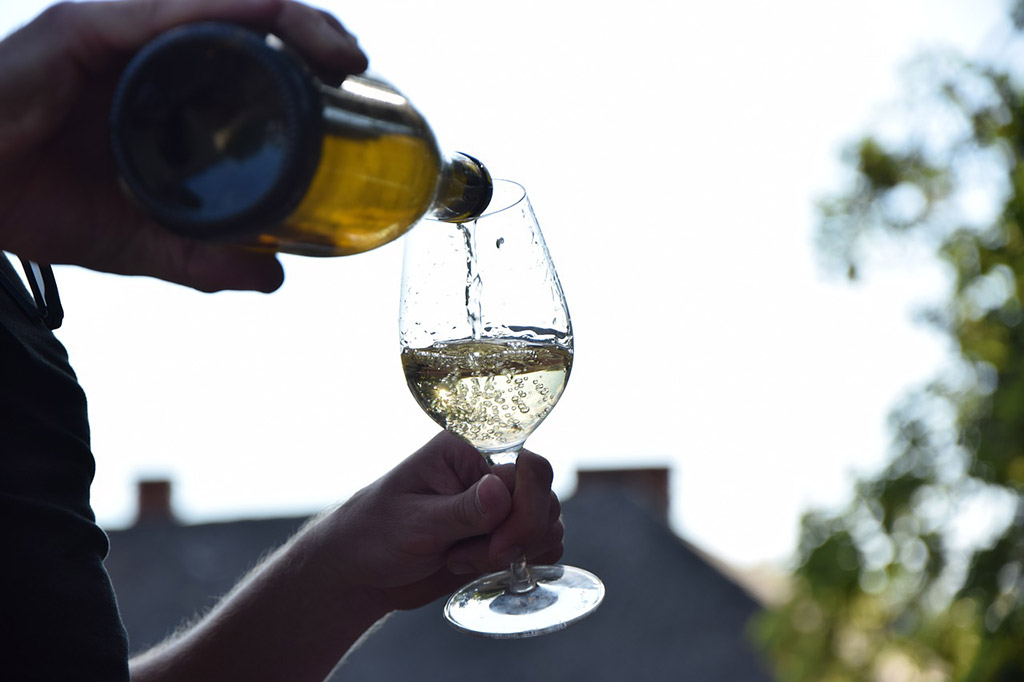White wine varieties

There are many different types of white wine, each with their own characteristic flavors and aromas. Learning how these varieties of white wine differ, and how their flavors, aromas, and other characteristics work, will help you pick the best white wines for any situation. All grape juice is basically colorless and white wines are created either from white and yellow grapes or red grapes after the skins have been removed. White wines tend to be lighter, sweeter, and less alcoholic than red wines.
Chardonnay
Chardonnay is the most common and well known variety of white grape in wine production today. The most prominent flavor in Chardonnay wine comes from oak used in the wine production process. Other flavors and aromas include fruit, lemon, melon, grass, and vanilla. Some other characteristics of Chardonnay wines are high acidity, golden colors, and a velvety feel in the mouth.
Chenin Blanc
The Chenin Blanc grape variety originates in the Loire Valley of France. Also called Steen when grown in South Africa, Chenin Blanc grapes are used to produce wines of varying quality. Favors and aromas of Chenin Blanc wines include fruit, honey, quince, and grasses. Other characteristics of wines made from Chenin Blanc grapes include an oily texture, high acidity, and a deep gold coloring. The specific characteristics of Chenin Blanc wines depend heavily on where they are grown.
Gewürztraminer
Gewürztraminer is German term which means "spicy (or perfumed) grape from Traminer," Gewürztraminer grapes are a cloned offshoot of the Traminer white grape, a variety that is uncommon today. Gewürztraminer flavors and aromas include spices, roses, passion fruit, and lychees. Other Gewürztraminer characteristics include high alcohol content and deep gold coloring. Although used to produce a white wine, Gewürztraminer grapes have pink or even red skins.
Riesling
Riesling grapes, which originate in Germany's Rhine region, have sweet fruity flavors and aromas of flowers and fruits. Other characteristics of wines made form Riesling grapes include high acidity and petrol notes if aged. The character of a Riesling wine depends heavily on where it is grown because Riesling grapes are very 'terroir expressive.' Rieslings cannot be oaked like Chardonnays and the oak flavor is part of what draws people to Chardonnay.
Sauvignon Blanc
Sauvignon Blanc is a versatile white grape variety that create white wines ranging in flavor from grassy to mineraly to fruity. Other Sauvignon Blanc flavors and aromas include apples, melons, peppers, and smoke. Sauvignon Blanc tends to be more grassy when picked early, more fruity when picked late. Sauvignon Blanc flavors also depend heavily on where the grapes are grown. The most famous wines made from Sauvignon Blanc grapes come from Bordeaux and the Loire valley in France.
Semillon
Semillon is grown widely in France where it is commonly blended with Sauvignon Blanc — for example, in Sauternes dessert wines — and it is one of only three varieties that can be grown in Bordeaux, France. In California, Semillon grapes are often used to produce generic white wines; Semillon can also produce a good variety wine on its own, though it's not as popular as other white wine grapes. Semillon grows well in many different climates and used to be grown far more widely than it is today
Torrontés
On the one hand the aromas of Torrontés are reminiscent of Gewürztraminer or Muscat; on the other hand, the texture and flavor are reminiscent of Sauvignon Blanc. Torrontés needs to be served well-chilled and protected from oxygen — too much warmth and/or too much exposure to oxygen will quickly eliminate its characteristic aromas. Torrontés is also best young because its flavors and aromas don't survive forever in the bottle.
You can get Torrontés wines from other regions, like New Zealand, but Argentinian Torrontés is the place to start. The word torrontés is Spanish for "torrent," a very appropriate label considering its potent flavors and aromas. According to marketing researchers, the primary consumes of Torrontes today are young female wine drinkers.
Viognier
Viognier is traditionally grown in France's northern Rhone valley, but it has also been doing well in the New World, for example California. Viognier wines from France's northern Rhone valley tend towards strong floral aromas; Viognier wines from Languedoc in the south of France tend to be drier, more acidic, lighter in texture, and have more citrus flavors. Wines made with Viognier grapes should generally be drunk young (before 18 months or so) and well-chilled.
Source: Wine Tasting Reviews
Author : Rafael Paniagua
Posted in: 11/30/-0001
Last modified: 12/09/2025
0 comments